ISRAEL
Plants and Animals

Plants and Animals
Cities in ISRAEL
| Eilat | Jerusalem |
Plants and Animals
Plants
The west of Israel still belongs to the Mediterranean region, with a lot of evergreen forests. One of the largest forests in the country is the 2,000 hectare area around Bar'am, Ein Zeitim and Biriya, which was planted by the Jewish National Fund in the 1950s on the treeless ridges around the city of Tsefat. The carob tree grows in the low plains and on the dunes.
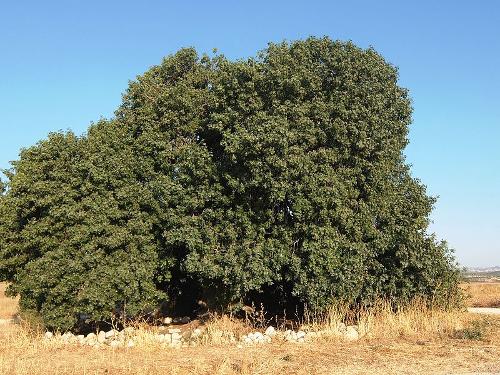 Pistacia atlantica, Elah Valley IsraelPhoto:Davidbena at en.wikipedia CC 3.0 Unported no changes made
Pistacia atlantica, Elah Valley IsraelPhoto:Davidbena at en.wikipedia CC 3.0 Unported no changes made
In the coastal mountains and as far as Jerusalem and Galilee, pine forest of Aleppo grows on chalk soil. Oak forests grow on sandy soils in these regions, which are mixed with Styrax officinalis and Pistacia atlantica as far as Galilee. Pistacia atlantica is one of the oldest trees that can be found in the Negev or Galilee. His predominant appearance is told in several biblical stories.
Inland, the mountains mainly contain scrub that is called "garrigue" in calcareous areas, and "maquis" on more acidic soil. This environment has a large number of plant communities, some of which are found nowhere else in the Mediterranean. Some special varieties are butterfly orchid, Calycotome villosa, Italian gladiolus, Cistus salviaefolius, Asiatic ranunculus, wild wheat, Galilee orchid and Helichrysum sanguineum.
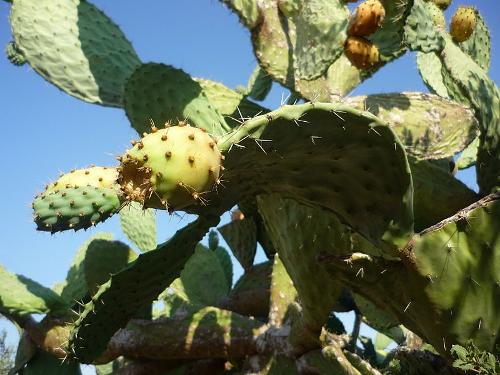 Sabra IsraelPhoto: Qasrawi 2000 CC 3.0 Unported no changes made
Sabra IsraelPhoto: Qasrawi 2000 CC 3.0 Unported no changes made
Everywhere in the Mediterranean area, planted and wild, one finds the Barbary fig, originally from South America (also called prickly pear cactus, in Israel called 'sabra').
To the east the vegetation changes into that of the steppe area, and here grows the stepped thorn thickets of the Zizyphus lotus, Zizyphus spina-Christi or jujube tree and Acacia arabica, all very tough plants that need little water.
The bank of the Jordan is virtually without vegetation. The Judean desert is barren and arid in summer, green in winter, and one large wild flower garden with sufficient rainfall in spring, including red anemones, yellow mustards, pink cyclamen, blue orchids and brown and purple irises. The approximately 160 nature reserves in Israel cover a total of 400,000 hectares and are home to more than 3000 plant species, of which approximately 150 are only found in Israel.
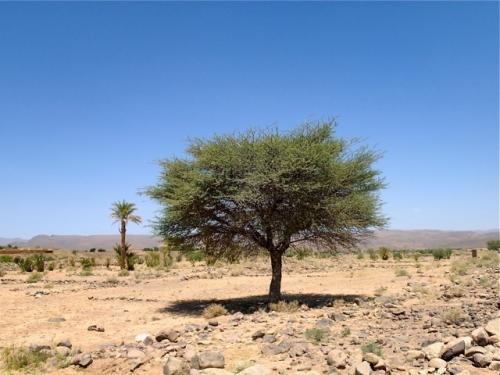 Acacia Raddiana, IsraelPhoto: Floratrek CC 3.0 Unported no changes made
Acacia Raddiana, IsraelPhoto: Floratrek CC 3.0 Unported no changes made
Some special biotopes:
The Arava Valley is part of the great Syrian-African Rift, which runs from East Africa to southern Turkey. The temperature in this area can reach over 40°C and the originally African flora feels at home in these circumstances. In some wadis the Acacia raddiana grows, a species of tree that also grows on the African savannas. Loranthus acaciae grows as a parasite on acacia trees and its honey is an important food source for some bird species. The Mesembryanthemum from South Africa has succulent leaves that can absorb a lot of water.
In the northwest, the Negev desert turns into a semi-desert with a remarkable flora. Mainly annual plants grow between Beershaba and Sede Boker; the most common are grasses, such as Stipa capensis. The turpentine or terebint has been growing in the Negev for thousands of years. The black iris can be seen between March and May in the calcareous areas of the Negev and the Judean desert. The asphodel flowers from January to April.
Animals
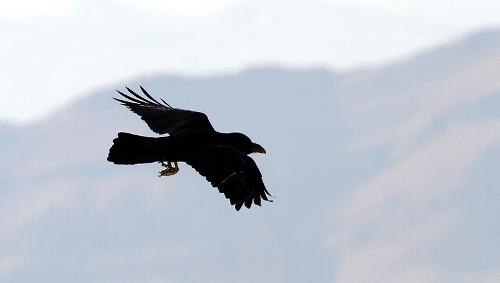 Raven, IsraelPhoto: Greg Schechter CC 2.0 Generic no changes made
Raven, IsraelPhoto: Greg Schechter CC 2.0 Generic no changes made
Over time, the species richness in Israel has decreased sharply, partly due to the large-scale clearing of forests, resulting in erosion. Only recently have many forests been replanted. Israel currently has about eighty reptile species and two hundred mammal species.
The panther is still found in very small numbers, just like the Syrian brown bear. Other recent species include the striped hyena, the common jackal, the common ichneumon or pharaoh rat, the hedgehog, the rock badger and a blind mouse (Spalax microphthalmus).
The approximately 400 species of bird world include the raven, the barn owl, the griffon vulture, the white wagtail, a sparrow (Passer biblicus), partridges and quail, the black-headed gull and the common pelican.
Insects and desert snails are particularly striking among invertebrates.
In the Negev desert, the Hai-Bar reserve has been set up for biblical fauna, partly through the import of onagers, Arabian oryxes and ostriches. Somali donkeys, caracals, jackals and wolves also live in this reserve.
Some special biotopes:
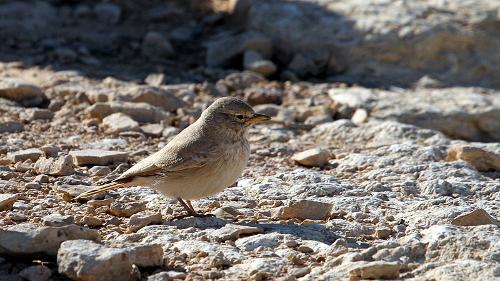 Desert Lark in IsraelPhoto: Greg Schechter CC 2.0 Generic no changes made
Desert Lark in IsraelPhoto: Greg Schechter CC 2.0 Generic no changes made
In The Arava Valley the Arabian gazelle is in danger of extinction in the Arabian peninsula; south of Yotvata is a reserve where this animal is protected. Furthermore, the striped hyena, the wild cat, the sand rat, the jumping mouse and the gerbil live here. The green bee-eater is a bird found only in this valley; other special birds are the red desert lark, the desert finch, the Palestinian honey bird and the common desert lark.
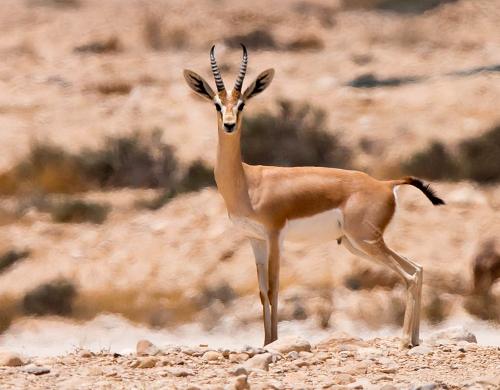 Dorcas Gazelle, IsraelPhoto: MinoZig CC 4.0 International no changes made
Dorcas Gazelle, IsraelPhoto: MinoZig CC 4.0 International no changes made
In the northwest of the Negev, the desert gives way to semi-desert, home to animal species that have become rare in Israel. The most striking animal is the wolf, which is also found in the desert of Judea and the Arava valley. Because the animal is protected, the Dorcas gazelle is still common in Israel, as well as the brown hare and the fox.
The following bird species inhabit the Negev: hooded crow, stone curlew, spotted sandgrouse, the protected crested bustard and the crested lark.
The wadis have a dry and desert-like environment and are a habitat for many desert animals. After downpours, water remains in hollows and pools, resulting in varied flora and fauna. The Nubian ibex lives in the highest parts of rocky mountains, at a lower level you can see the cliff badger, which is related to the elephant!
As far as birds are concerned, the following stand out: desert wheatear, fan-tailed raven, Sinai rosefinch and Tristram starling.
Israel's geographic location, where three continents meet, means incredible numbers of migratory birds land twice a year. Thanks to the rising air currents, these birds can quickly travel thousands of kilometers.
Among the many bird species are also many birds of prey, such as steppe eagle, black kite, Balkan sparrow, steppe hawk, honey buzzard and screaming eagle. The stork and the black stork also cross the Holy Land twice a year.
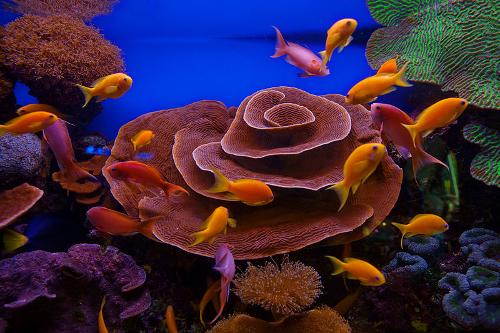 Coral reef Red Sea, IsraelPhoto: Israeltourism CC 2.0 Generic no changes made
Coral reef Red Sea, IsraelPhoto: Israeltourism CC 2.0 Generic no changes made
The Red Sea is famous for its colorful fish, corals and invertebrates, which are part of the Indo-Pacific fauna. In the immediate vicinity of coral reefs you will find the greatest diversity of fish, which find food and shelter there. The so-called fringe reef has the greatest diversity of species. This is somewhat less at the higher plate reef and the lower deep reef.
The following list is just a small selection of the many species: four-eyed magician, blue parrotfish, masked puffer fish, wrasse, gray moray eel, gold-tail magician, surgeon fish, blue surgeon fish, clownfish, rock fish, boxfish and grouper.
Special life forms are: soft coral, red sponge, sea urchin, sea anemone, tube sponge, slug, sand tube worm, fire coral and barber shrimp.
The Mediterranean zone has been deforested by humans since the Stone Age, but there are still plenty of special animals, such as the Spurr-tighed tortoise and the mongoose. Common birds include lesser kestrel, red-rumped swallow, gray bulbul, goldfinch, black-headed lesser and turtle-dove.
Sources
Cahill, M.J. / Israel
Chelsea House Publishers
Gerhard, C. / Israël
Van Reemst
Griver, S. / Israël : inclusief de Palestijnse Autonome Gebieden
Kosmos-Z&K
Groeneveld, M. / Israël: een leesboek
Boekencentrum
Het Heilig Land
Standaard
Rauch, M. / Israël
ANWB
Sanger, A. / Israël
Van Reemst
Semsek, H.-G. / Israël : Westelijke-Jordaanoever, excursies naar Jordanië
Het Spectrum
CIA - World Factbook
BBC - Country Profiles
Copyright: Team The World of Info